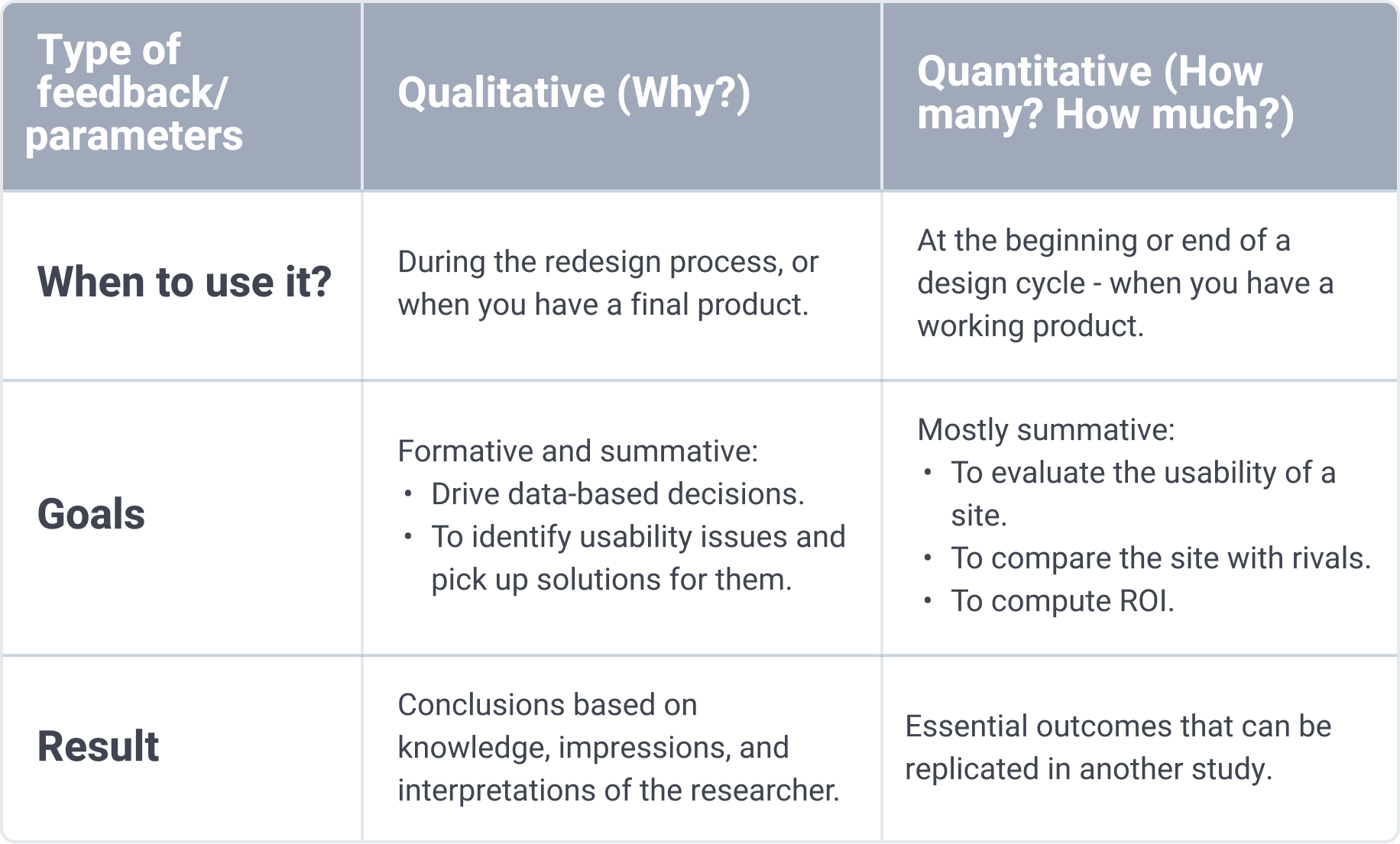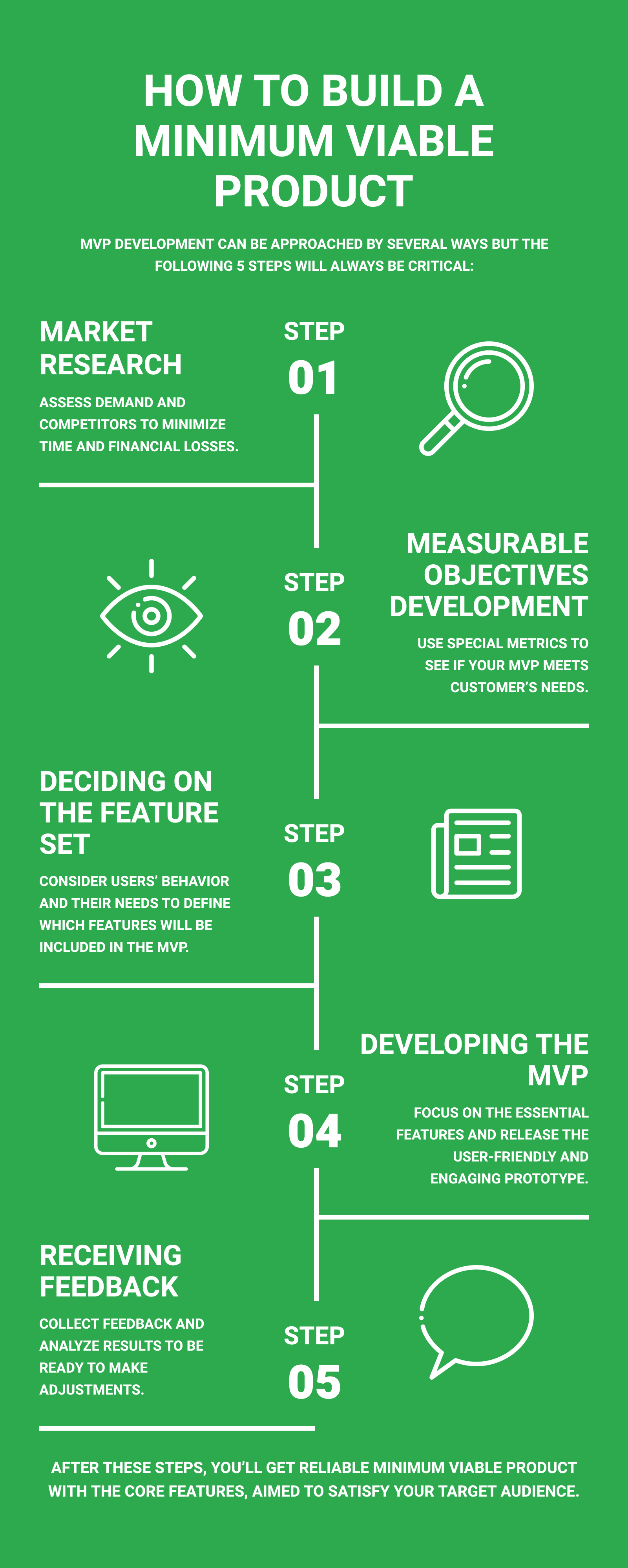Startup teams strive to deliver value and help their products grow with fewer people, limited resources, and reasonable budgets. They must concentrate on the right actions at the right time, minimizing waste.
The concept of a minimum viable product (MVP) allows you to understand if customers really need the product without wasting efforts on the development of a complex and expensive solution that will fail in the market. Building an MVP helps you test your hypotheses and gauge customer interest so that the team can work toward product-market fit.
Some startups hire in-house development teams to create MVPs, others outsource this to software development companies. Whichever you choose, you’ll find answers to any questions you have about MVP development for startups in this article. Read on to learn why your startup needs an MVP, what pitfalls you should avoid when developing a minimum viable product, what metrics you should track when evaluating success, and how to grow your MVP into a full-scale solution.

What Is a Minimum Viable Product?
A minimum viable product is a launchable version of a product that contains only must-have features. These features define the value proposition and are sufficient to deliver the product to its first users.
An MVP enables validation of a product idea early in the development cycle (the full set of features is typically developed after gathering feedback from early users). The main idea of a minimum viable product is to achieve product-market fit, shorten the time to market, and attract early adopters.
Note: Do not confuse an MVP and a prototype. A prototype is a first draft of the future product, a low-functional artifact. It reflects the idea or functionality of the product and allows you to quickly test the ideas and hypotheses behind it. An MVP, in turn, is a working version of the product with a set of core features.
3 Reasons Why Your Startup Should Build an MVP
Creating a successful product begins with MVP development. Its primary purpose is to assess how realistic and profitable the idea is, test it in practice, and discover possible flaws. Here are some other important purposes for which startups create MVPs:
- Speed time to market. The faster your product is launched to users, the quicker you can test your business concepts and avoid adding superfluous features before launch.
- Collect users’ feedback and assess product-market fit. The feedback of early adopters can be more valuable than the predictions of experienced consultants or business analysts. The earlier your customer tries your product, the faster you can introduce crucial changes.
- Attracts investors. With a tested MVP, you have a higher chance to be noticed by investors and angels, because they are not willing to pay for the raw idea, but want to see the product.
7 Common Mistakes to Avoid While Working on Your MVP
To create a successful minimum viable product, you should avoid some minor (at first sight) pitfalls that can result in an epic business failure. Here’s the list of these mistakes.
1. Striving to be the best
Remember that your main goal is to give customers a basic sense of what your future product will look like by introducing its core features. If your idea looks dubious in the market, overburdening the MVP with more features will be a waste of effort. Try to reserve energy for the case that it will be approved later.
2. Trying to solve the wrong problem
Before spending your efforts on developing a product, try to define whether it is worth creating or not. First, find the door and then seek the key. A good-looking key is useless if it can’t open the right door, right?
3. Ignoring the prototype stage
Building a physical product without referring to a visual model is impossible. Jumping straightway to the development phase without defining requirements also looks difficult. A prototype is what lies between an idea and a product. It focuses on the product’s “how” part. Prototyping looks like a version for visualizing the user experience of the minimum viable product.
4. Skipping feedback
To assess the viability of the product, you need to gather user feedback. This way you can gain some actionable insights about your idea and understand if it is good and what parts need to be fixed. Therefore, it is important to keep a close eye on the feedback at every stage.
5. Choosing the wrong development method
Working on MVP development without prior knowledge of the appropriate development method is a severe reason for startups to give up the project halfway. You definitely know the most popular approaches to MVP product development – Agile and Waterfall. The Agile methodology seems to be more efficient compared to the Waterfall approach. It focuses on incremental and iterative development and offers a flexible system. However, the “Agile vs. Waterfall” controversy is still alive among developers around the world.
6. Targeting the wrong persona
Once the MVP prototype is ready, it’s time to test it and get feedback from your target audience. You should not ask your relatives and friends to participate in this process unless they are potential customers. It will save you from irrelevant feedback that can lead to the product being dumped for the wrong reasons.
7. Confusion between quantitative and qualitative feedback
You can use quantitative and qualitative feedback to collect data from your users. Both are crucial to finding the right balance to come to a well-rounded conclusion. Qualitative feedback is about insights related to the quality and usability of product features. Quantitative feedback provides insights into whether the tasks were easy or difficult to complete. Try to combine these two types of feedback, as this will help to control possible threats. Here’s a brief comparison of both types of feedback:

Now that you know why your startup needs an MVP it is time to move on to the specific steps for creating it. Are you ready? Then go ahead.
How to Create a Minimum Viable Product: 5 Consistent Steps
There are five key steps you should follow to succeed in this way:
- Market research
- Measurable objectives development
- Deciding on the feature set
- MVP development
- Receiving feedback and analyzing results

Step 1. Market research
This is the first and most important step you should take, no matter how innovative your idea is. Market research will help you assess demand and analyze the competition to minimize time and financial losses. With its help, you can gain a competitive advantage, and identify the key points that make your idea viable and the problems it can solve. Remember that the key to an effective MVP is to demonstrate to your audience the value your product will provide.
Step 2. Measurable objectives development
It is about defining specific metrics that will measure success. Let’s assume that your purpose is to develop an app. In that case, you can measure the total number of downloads, the number of downloads in a certain period, the time that users spend on your app, review score, and many more factors that will help you see if your MVP meets your customer’s needs.
Step 3. Deciding on the feature set
Now it’s time to define what your product will actually look like. Put yourself in your users’ shoes and consider their behavior to identify the sequence of actions to solve their problems. Think about what people are thinking and feeling while using your product. At this stage, you need to understand which features will be included in the minimum viable product development process. Consider those that provide more benefits to users as the core of your product.
Step 4. Developing a minimum viable product
At this stage, you are all set to build an MVP. Focusing on the core features will enable you to deliver the solution to its first users as fast as possible. After releasing the MVP, you can prioritize other features for implementation.
Step 5. Receiving feedback and analyzing results
Measuring results is a kind of true test of the viability of your products. Consider what users say and adapt your product to the needs of the market. Adjusting the MVP according to the test results will lead to better conversion when the final version is released.
3 Points to Consider When Framing an MVP for a Startup
1. Creating a list of your success criteria
It may seem simple, but many managers don’t have established success criteria. If you want your startup to succeed, develop it in a measurable style so you can calculate ROI. You should also set a long-term goal. Once you’ve completed the MVP process, you can move to the next step. Consider your goals and objectives, as well as the structure of your business.
2. Defining the user’s journey
A good idea is to visualize the user’s journey from A to Z to see how they interact with your solution. It will help you identify how many steps the user will take and optimize them, prioritizing activities and increasing value.
3. Addressing pain points
Fixing the problem that is bothering users and developing a long-term company around it are the main reasons why you’re putting in all this effort. So make sure you address users’ real pain points as you work on the solution and then build your MVP around them.
How to Measure Success After Implementing an MVP
No surprise that the process of detailed success measuring is also vital. You can apply different methods to predict your product’s future success. Here’s the list of the most popular and reliable ways to gauge the MVP’s success:
✅ Engagement
Engagement will demonstrate the current and future worth of your product. It will help your company to enhance the user experience.
✅ Customer reviews
Ask for customer feedback to get a deeper insight into the strong and weak points of your future product. You can even ask for their ideas on how to improve the product and consider implementing the most popular requests. Offer something valuable in exchange for their time to write a review, say, a subscription discount or a small gift.
✅ Active users
Check the user behavior after they try your product. Do they stop using it after a day? Or do they keep using your product for at least a month? Study user behavior to spot the most popular functionality and invest your effort in improving it.
✅ Churn
Watching active users, you can even notice early signs of customer churn and understand what exact factors make users abandon your product. This way, you can spot weaknesses that you have missed. Measure churn for free and paid users separately to make this metric more precise.
✅ Sign-ups and downloads
This is one of the most crucial metrics because it shows whether your product indeed can solve a particular problem. By analyzing the sign-ups, you can measure the potential interest in your future product and validate your idea one more time before you invest too much in the development of a product. In addition, you can analyze the sources that bring you the majority of conversions and get vital info to later update your marketing strategy.
✅ Paying users
This metric will help you track revenue-generating services and define the average revenue per user (ARPU).
✅ Customer acquisition cost
The understanding of how much it costs to get a paying customer allows you to realize whether your marketing strategy works or needs changes.
Moving From an MVP to a Full-scale Product: How to Make a Smooth Transition
According to Investopedia, 90% of startups fail. Why does it happen? A considerable amount of effort should go into the process even after the launch of an MVP. Here are some actionable tips that will help you move from your MVP to a full-scale product.
1. Be ready to scale
Startups typically worry about testing their assumptions and gaining tremendous traction. They think about scalability at a later stage. However, it is a good idea to always be prepared as there is a chance that your MVP will catch on quickly. So, at the start of the project, take your time to shortlist potential reliable partners, such as companies focused on software consulting, development, and dedicated teams.
2. Pick an optimal monetization model
After launching a minimum viable product, startups often defer the pricing quotient, thinking that their product is not ready yet. However, even the MVP can be set to go on a journey of success. Do not doubt to analyze the demand for your product and try to find an optimal monetization approach.
3. Pay enough attention to marketing
Once your MVP solution gets launched in the market, you should be ready with your marketing strategy to let the world know that your product is an absolute masterpiece. Start a promotion campaign as soon as the MVP is launched.
Summary
An MVP is your best helper when you need to validate your product concept with minimal investment. By building it properly, you’ll ensure you take the right user-centric approach and gain the valuable insights you need to create a long-term product. All it takes is to formulate a business hypothesis, define the core startup MVP features and the target audience, and partner with the right MVP development company. If you follow the described steps and strategies to build an MVP, new opportunities will open up to you – take advantage of them!